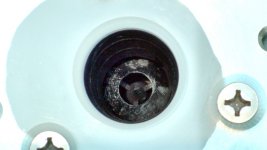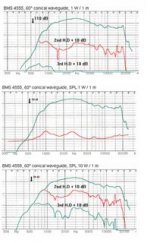soongsc said:Playing around with wave guide/horn the impedance peak seems to show two peaks blended, impedance phase crosover actually become lower than F0. This seems quite interesting.
You should never rely on the impedance characteristic of a horn loaded system because it may drift with time and may change depending on system placement. This always calls for an active system, particularly for midrange and bass horns/waveguides.
You will usually find a wide impedance peak due to compression driver resonance with some dips across it due to horn/waveguide resonant modes, which damp the main resonance locally at some frequencies. All these peaks may shift a little in position and Q with time and system placement, not to mention if you replace a bad diaphragm assembly by a new one (consider aging and production tolerances).
Eva said:This always calls for an active system, particularly for midrange and bass horns/waveguides.
You will usually find a wide impedance peak due to compression driver resonance with some dips across it due to horn/waveguide resonant modes, which damp the main resonance locally at some frequencies. All these peaks may shift a little in position and Q with time and system placement, not to mention if you replace a bad diaphragm assembly by a new one (consider aging and production tolerances).
I'm sorry, but I don't agree here at all. To repeat, I don't use active and I get exceptional performance.
And I have not seen any drift of a waveguide due to time or placement - sorry, I just don't accept that this is possible to any significant extent.
Consider a slightly peaky/shrunk midrange or bass horn/waveguide. The frequencies and Q of the lower resonant modes become fully dependent on spatial loading. From 4pi to 0.5 pi they may easily shift 1/3 of octave or even 1/2.
If you use huge "complete" horns/waveguides this won't happen, but this is only suitable for tweeters if you want to end up with a system of practical size.
Note that I don't like direct radiators, I like full horn systems.
If you use huge "complete" horns/waveguides this won't happen, but this is only suitable for tweeters if you want to end up with a system of practical size.
Note that I don't like direct radiators, I like full horn systems.
I don't like full horn systems and only use waveguides where the directivity is required. In this domain there is no loading shift or time shift of anything. Only for a very large horn such that its mouth was appreciably the size of the room could this occur (loading changes that is, I still don't see how shifts in time can occur from the horn. The driver maybe, but not the horn.)
If you notice my prior posts, I currently am trying a direct rediating driver instead of a compression driver. Compressions drivers have effects that creat thos multiple peaks that I do not quite like, mostly due to the compression chamber and plug interaction. Dr. Klippel did some compression driver impedance measurements in a vacume chamber which showed only one resinance F0. I think the basic sound producing method is the vibrating membrane, the beter and simpler this can be integrated with the horn/guide, the better the result.Eva said:
You should never rely on the impedance characteristic of a horn loaded system because it may drift with time and may change depending on system placement. This always calls for an active system, particularly for midrange and bass horns/waveguides.
You will usually find a wide impedance peak due to compression driver resonance with some dips across it due to horn/waveguide resonant modes, which damp the main resonance locally at some frequencies. All these peaks may shift a little in position and Q with time and system placement, not to mention if you replace a bad diaphragm assembly by a new one (consider aging and production tolerances).
I think the impedance should not change unless the guide/horn is too small for the driver whether intentional by design or other reasons. But anyway, looking at all data in the process of essamling the horn.guide in segments definitly helps understanding.
"Never let pride stand in the way of thy goal", they say.Russell Dawkins said:
"Pride goeth before a fall", they say.

soongsc said:
I think the basic sound producing method is the vibrating membrane, the beter and simpler this can be integrated with the horn/guide, the better the result.
I see no rational for that statement and in fact I can think of several aspects that would refute it. Phase plugs are positive things not negative. Directly feed waveguides can work well if feed by rigid FLAT pistons, but cone drivers will have problems.
The fact that you had a different phase plug design in mind, I'm sure that those on the market are just not done right. So when we see one that is done right, then I will agree.
To expect a flat piston to be light enough and rigid enough for frequencies 16KHz is beyond my imagination. Concaved dome seemed to have a wider dispersion which hopefully makes it easier to get control of directivity.
To expect a flat piston to be light enough and rigid enough for frequencies 16KHz is beyond my imagination. Concaved dome seemed to have a wider dispersion which hopefully makes it easier to get control of directivity.
Well, simple diaphragm geometry generats a simple wave front which is easier to deal with IMHO.
Are there any CDs with inversed cone/dome ?
From a previously picture of the inside of the B&C DE250 it shows what looks like a rather crude metal plate with the narrowing 1" hole...are they all made so crudely simple at this point
ups, offtopic, sorry 😀
From a previously picture of the inside of the B&C DE250 it shows what looks like a rather crude metal plate with the narrowing 1" hole...are they all made so crudely simple at this point
ups, offtopic, sorry 😀
Tinitus
I am sorry but I couldn't disagree more. The B&C compression drivers are exceptional products with a very high precision design. There is nothing "crude" about them at all.
Which way is "inversed"? Concave or convexed? Most high performance CDs are concave domes as this minimizes path length differences to the throat. There are some special designs that use cones and domes in combination, but these are high powered pro units.
I am sorry but I couldn't disagree more. The B&C compression drivers are exceptional products with a very high precision design. There is nothing "crude" about them at all.
Which way is "inversed"? Concave or convexed? Most high performance CDs are concave domes as this minimizes path length differences to the throat. There are some special designs that use cones and domes in combination, but these are high powered pro units.
Sorry, but this picture says to me that the outside is pretty, but what you cant see appears more shabby or sloppy...I didnt speak when I first saw the picture, but it was my first thought
But I believe you when you say its good enough and actually sounds better than many others
But I believe you when you say its good enough and actually sounds better than many others
Attachments
btw, I am not even sure that most other affordable CDs are any better on the matter on inside quality, "inner beauty", but I only hope
I am not even sure it would matter much in terms of sound quality, but I somehow like good build quality through out and believe that in the end it will reflect on sound...and no, I am not rich either...no GOTO in sight
btw, I reckon I will invest my money in FaitalPro and Azura, and live in the hope
I am not even sure it would matter much in terms of sound quality, but I somehow like good build quality through out and believe that in the end it will reflect on sound...and no, I am not rich either...no GOTO in sight
btw, I reckon I will invest my money in FaitalPro and Azura, and live in the hope

tinitus said:I am not even sure it would matter much in terms of sound quality, but I somehow like good build quality through out and believe that in the end it will reflect on sound...
I have not found this to be the case, to wit TAD drivers whose build quality is superb, but whose sound quality was shown to be no better than equivalent B&C drivers at 1/10 the price. Go ahead an spend what you want on "inner beauty" in hopes that it will sound better, but my advice is to not equate price and apperances with sound quality. "Inner beauty" costs a lot more to do.
Don't forget the ring radiator compression drivers from BMS, like the 4552 Nd. In my experience they outperform domes because the path length problem is completely solved and diaphragm breakup is solved too.
Thanks Eva, I have been looking at BMS...I think the 1.5" 4555 looks smooth, low distortion with no "hickups"
but its no neo driver...any comments ?
http://bmspro.com/4555.845.0.html
I was actually aiming at Faital 1" HF10TX, which is already on backorder at USspeaker...does that tell something ?
Also I may consider the BMS 2" mid driver 4591, and use maybe Hivi RT2-pro as supertweeter...but complicates things considerably
but its no neo driver...any comments ?
http://bmspro.com/4555.845.0.html
I was actually aiming at Faital 1" HF10TX, which is already on backorder at USspeaker...does that tell something ?
Also I may consider the BMS 2" mid driver 4591, and use maybe Hivi RT2-pro as supertweeter...but complicates things considerably
Attachments
I wonder why there seems to be a high peak close to 20KHz that is quite close to where a normal breakup mode is. Wish I could see some CSD and impulse plots.Eva said:Don't forget the ring radiator compression drivers from BMS, like the 4552 Nd. In my experience they outperform domes because the path length problem is completely solved and diaphragm breakup is solved too.
Do you know where information explaining the path length problem is solved can be found?
soongsc said:
I wonder why there seems to be a high peak close to 20KHz
Apart from the 1.5" BMS I show above, you are right about the peak just below 20khz...actually its also present on the 2nd HD graphs...funnily its almost gone on the 10W SPL graphs 😕
http://bmspro.com/Curves.curves1.0.html
- Home
- Loudspeakers
- Multi-Way
- Geddes on Waveguides

